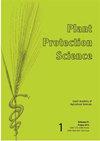考虑食物偏好的粮仓虫冢结构的形成
IF 1.4
4区 农林科学
Q2 AGRONOMY
引用次数: 0
摘要
在这篇文章中,特别关注了考虑到生态(食物)因素的白俄罗斯粮仓中昆虫虫的形成的研究结果。首次考虑了库存害虫种类数与小麦、大麦、小黑麦、燕麦和黑麦仓库害虫数量的比值,分析了物种丰富度。物种丰富度指数的比较显示:小麦的最大值为1.53点,黑麦的最小值为0.93点。在饲料偏好的基础上,首次计算了各害虫的密度(丰度)。观察了粮仓害虫在食物偏好影响下优势结构的形成规律。无论储存的作物是什么,都发现有革螨,并占绝对优势(58.3 - 100%)。储粮小麦的优势种为小螟虫(29.2%)和谷甲虫(16.7%),储粮小黑麦的优势种为白纹蜘蛛甲虫(19.0%),储粮大麦的优势种为小螟虫(14.6%),储粮燕麦的优势种为稻象甲(18.1%)。只有大麦(0.7%)和燕麦(1,0%)的copeogata是次近的。在仓库采取保护措施时,必须考虑到已确定的趋势。本文章由计算机程序翻译,如有差异,请以英文原文为准。
FORMATION OF ENTOMOACARAFAUNA STRUCTURE OF GRANARIES TAKING INTO ACCOUNT FOOD PREFERENCE
In the article a special attention is concentrated on the results of the research on the formation of entomoacarafauna of granaries of Belarus, taking into account the ecological (food) factor. For the first time, the species richness was analyzed, taking into account the ratio of the number of stock pest species and their number in warehouses where grain of wheat, barley, triticale, oats, and rye is stored. A comparison of species richness indices is shown: for wheat, the maximum value is set (1,53 points), for rye - the minimum one (0,93 points). For the first time, the density (abundance) of each pest species formed in technocenoses was calculated taking into account fodder preferences. The regularity of formation of the dominance structure of pests in granaries under the influence of their food preferences was observed. Acariformes were found regardless of the stored crop and were eudominant (58,3–100 %). The dominant species from Coleoptera were lesser grain borer (29,2 %) and grain beetle (16,7 %) for stored wheat, white marked spider beetle (19,0 %) for stored triticale, lesser grain borer (14,6 %) for stored barley and rice weevil (18,1 %) for stored oats. The Copeognata was characterized as subrecedent only for barley (0,7 %) and oats (1,0 %). The identified trends must be taken into account when taking protective actions in warehouses.
求助全文
通过发布文献求助,成功后即可免费获取论文全文。
去求助
来源期刊

Plant protection science
Agronomy-PLANT SCIENCES
CiteScore
2.90
自引率
7.70%
发文量
30
审稿时长
12 weeks
期刊介绍:
Original papers, short communications, critical reviews, personal news, and book reviews covering all areas of diseases and pests of plants, weeds and plant protection. Papers are published in English.
 求助内容:
求助内容: 应助结果提醒方式:
应助结果提醒方式:


